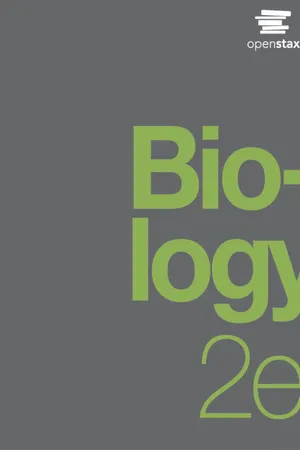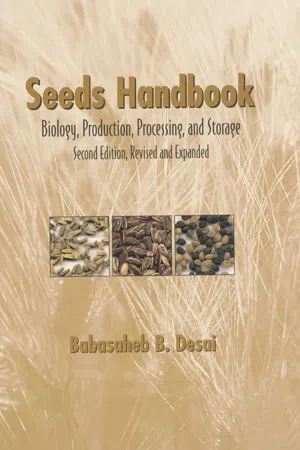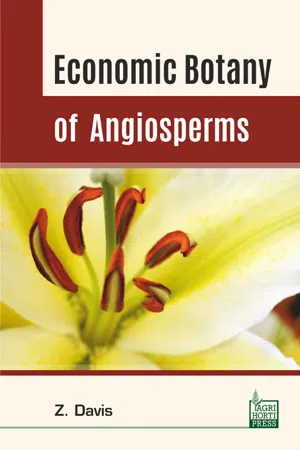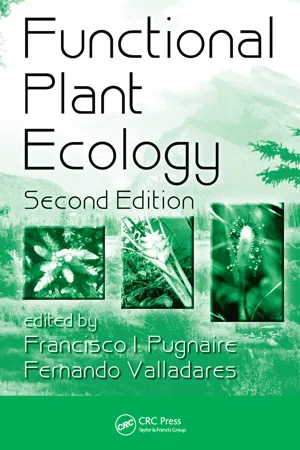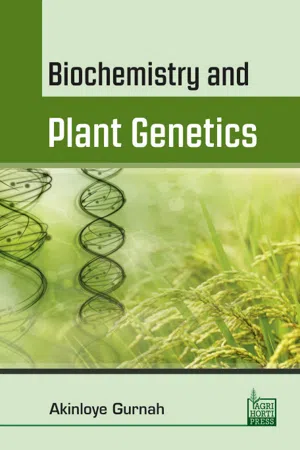Biological Sciences
Angiosperm Life Cycle
The angiosperm life cycle is characterized by alternation of generations, with a dominant sporophyte stage and a reduced gametophyte stage. It involves the production of flowers, which contain the reproductive structures of the plant. The process of double fertilization leads to the formation of seeds within fruits, enabling angiosperms to disperse and reproduce efficiently.
Written by Perlego with AI-assistance
Related key terms
1 of 5
8 Key excerpts on "Angiosperm Life Cycle"
- eBook - PDF
- Mary Ann Clark, Jung Choi, Matthew Douglas(Authors)
- 2018(Publication Date)
- Openstax(Publisher)
Chapter 26 | Seed Plants 745 Figure 26.15 Angiosperm Life Cycle. The life cycle of an angiosperm is shown. Anthers and carpels are structures that shelter the actual gametophytes: the pollen grain and embryo sac. Double fertilization is a process unique to angiosperms. (credit: modification of work by Mariana Ruiz Villareal) Question: If a flower lacked a megasporangium, what type of gamete would not form? If the flower lacked a microsporangium, what type of gamete would not form? The ovule, sheltered within the ovary of the carpel, contains the megasporangium protected by two layers of integuments and the ovary wall. Within each megasporangium, a diploid megasporocyte undergoes meiosis, generating four haploid megaspores—three small and one large. Only the large megaspore survives; it divides mitotically three times to produce eight nuclei distributed among the seven cells of the female gametophyte or embryo sac. Three of these cells are located at each pole of the embryo sac. The three cells at one pole become the egg and two synergids. The three cells at the opposite pole become antipodal cells. The center cell contains the remaining two nuclei (polar nuclei). This cell will eventually produce the endosperm of the seed. The mature embryo sac then contains one egg cell, two synergids or “helper” cells, three antipodal cells (which eventually degenerate), and a central cell with two polar nuclei. When a pollen grain reaches the stigma, a pollen tube extends from the grain, grows down the style, and enters through the micropyle: an opening in the integuments of the ovule. The two sperm are deposited in the embryo sac. A double fertilization event then occurs. One sperm and the egg combine, forming a diploid zygote—the future embryo. The other sperm fuses with the polar nuclei, forming a triploid cell that will develop into the endosperm—the tissue that serves as a food reserve for the developing embryo. - eBook - PDF
- Cecie Starr, Christine Evers, Lisa Starr, , Cecie Starr, Cecie Starr, Christine Evers, Lisa Starr(Authors)
- 2020(Publication Date)
- Cengage Learning EMEA(Publisher)
Life Cycles of Flowering Plants 29.1 Plight of the Honeybee 611 29.2 Flower Structure and Function 612 29.3 Sexual Reproduction in the Flowering Plant 615 29.4 Seeds and Fruits 618 29.5 Early Development 620 29.6 Asexual Reproduction in Plants 622 29.7 Plant Hormones 623 29.8 Growth Responses 628 29 A shower of pollen from a heliconia flower sprays the face of a spiderhunter sipping nectar from it. Pollen that sticks to the bird’s feathers can be transferred to another flower—pollinating it—on a subsequent visit. CONCEPT CONNECTIONS You may want to review what you learned about meiosis in sexual reproduction (Section 9.5), and the life cycles of angiosperms (15.7). This chapter also revisits plant cell structure and function (3.6, 28.5), starch (2.7), receptor proteins (3.3), turgor pressure (4.5), pigments (5.3), clones (7.1), asexual reproduction (9.2), senescence (9.4), polyploidy (10.8), cell signaling (13.6), viruses (14.7), gametophytes and pollen (15.2), arthropods (16.5), animal hormone function (26.2), circadian rhythms (26.4), monocots and eudicots (28.2), stem structure (28.3), root structure (28.4), and plant growth (28.6). Evolutionary themes include adaptive traits (12.3), convergent evolution (12.6), factors that reduce genetic diversity (13.5), mechanical isolation (13.6), and coevolution (13.7). iStockphoto.com/momnoi Copyright 2021 Cengage Learning. All Rights Reserved. May not be copied, scanned, or duplicated, in whole or in part. Due to electronic rights, some third party content may be suppressed from the eBook and/or eChapter(s). Editorial review has deemed that any suppressed content does not materially affect the overall learning experience. Cengage Learning reserves the right to remove additional content at any time if subsequent rights restrictions require it. - Caula A. Beyl, Robert N. Trigiano, Caula A. Beyl, Robert N. Trigiano(Authors)
- 2016(Publication Date)
- CRC Press(Publisher)
• Mutation breeding and biotechnology can be used to breed new cultivars from clonal material without sexual reproduction. 66 Timothy A. Rinehart, Robert N. Trigiano, Phillip A. Wadl, and Haley S. Smith thousands upon thousands of exact genetic copies of ‘Cherokee Sunset.’ In the end, the consumer receives the desired product with the expected characteristics. Other horticultural plants, especially many bedding species and vegetable crops, are propagated mainly by seeds. This is a sexual process that entails meiosis in both the male and the female cells to form haploid gametes. The original diploid number of the chromosome is restored by the fusion of the haploid gametes from each parent. As will be discussed below in more detail, sexual reproduction in angiosperms involves pollination, in which the pollen or the male gametophyte lands on receptive female sur-faces, usually the stigma of the ovary. Eventually, a pro-cess called “double fertilization” takes place, in which one male sperm nucleus fuses with the female egg to create the zygote and another sperm nucleus fuses with two other nuclei of the female gametophyte to form the primary endosperm nucleus. The result of sexual reproduction is a seed containing an embryo and everything necessary to grow a new seedling. ALTERNATION OF GENERATIONS The concept of alternation of generations is central to understanding sexual reproduction in angiosperms as well as most other organisms. In this case, generations do not refer to parents and children, but rather to the nuclear condition or the ploidy number of the plant’s cells during the life cycle of the plant. Ploidy level is the number of copies of chromosomes in the nucleus.- eBook - PDF
Seeds Handbook
Processing And Storage
- Babasaheb B. Desai(Author)
- 2004(Publication Date)
- CRC Press(Publisher)
4. Increasing crop yields by improving the way plants use the sun's energy during photosynthesis. The ultimate importance of biotechnology for plant science is that it provides a tool for the transfer of any gene from any source into plants (4). II. FLOWERING, FRUIT, AND SEED DEVELOPMENT Fruits and seeds in angiosperms are derived from flowers in a sequential process involving flower bud induction and initiation; flower differentiation and development, pollination, and fertilization; fruit set and seed formation, growth, and development of fruit; and seed and fruit senescence. The flowers in angiosperms are the specialized modified leaves borne or arranged on the stem primarily for sexual reproduction. Such plants grow vegetatively until they are fully mature to produce flowers, at which stage certain environmental stimuli such as light and temperature can trigger the transfor-mation of vegetative meristems into reproductive meristems. This transformation takes place well ahead of actual flowering. Depending upon the plant species, the time required to attain vegetative maturity varies from a few days (flowering annuals) to several days (forest trees). However, flower bud initiation in some bulb crops takes place before sprouting. At maturity, most flowering plants become sensitive to environmental stimuli. A. Photoperiodism and Vernalization Flowering in some crop plants is induced by changes in day length (photoperiodism) and/or low temperatures (vernalization). The photoperiodic effects on flowering were first discovered in 1920 by W. N. Garner and H. A. Allard, plant physiologists in the U.S. Department of Agriculture, who observed that the Maryland Mammoth tobacco and Biloxi and other varieties of soybean, which normally bloom in autumn, could be made to flower in June or July by subjecting them to artificially shortened days and - eBook - PDF
- Davis, Z(Authors)
- 2018(Publication Date)
- Agri Horti Press(Publisher)
Whatever the mechanism, the pollination process involves limited exposure of the male gametes and utilizes the existing forces in the environment. Double Fertilization Once the pollination has taken place, the megagametophyte matured, and the pollen tube grown to the ovule, the life cycle can continue. The next step is the actual fertilization process. The pollen tube grows from the style to an ovule in the ovary. It is unable to grow through the integument and instead grows around the ovule until it reaches the micropyle. The pollen tube grows through the micropyle and remaining megasporangium to the embryo sac. The point This ebook is exclusively for this university only. Cannot be resold/distributed. Economic Botany of Angiosperms 266 of entry to the embryo sac is right at the position of the egg cell. The pollen tube opens, the tube nucleus disintegrates and the two sperm nuclei are released into the embryo sac. One of the two nuclei is incorporated into the egg cell, fuses with the egg nucleus and produces a diploid, zygotic nucleus and the egg becomes the zygote or first cell of the next sporophyte generation. The other sperm nucleus fuses with the two polar nuclei producing a triploid, endosperm nucleus. Since fertilization is simply described as the fusion of two nuclei, then in fact, in the embryo sac, two fertilization events have taken place. This is termed double fertilization and results in the formation of the 2n zygote and 3n endosperm. At this point several changes in the flower take place. First, the corolla and stamens usually drop off. The stigma and style wither. The ovary wall and sometimes other floral structures begin to develop into the fruit. The fertilized ovule is then termed the seed and the integument develops into the seed coat. The endosperm quickly divides to produce a mass of nutritive endosperm tissue and the zygote divides and differentiates into the embryo. - eBook - PDF
- Francisco Pugnaire, Fernando Valladares, Francisco Pugnaire, Fernando Valladares(Authors)
- 2007(Publication Date)
- CRC Press(Publisher)
The major speciation has indeed occurred in the angiosperms, a group represented by over 220,000 species (Cronquist 1981). Such species richness is due to different factors (see Section ‘‘Diversification of Angio-sperms’’), of which perhaps the most important is the wider range of growth forms that allow them to inhabit a wider range of habitats than either pteridophytes or gymnosperms. The latter are mostly trees, which restrict the number of habitats where they can live, have limited breeding systems, limited pollination systems, and unspecialized seed dispersal (Givnish 1980). The development of a gynoecium (pistil) in the angiosperms (term meaning enclosed seeds) has probably been one of the most important steps in the evolution of plants. Seed plants have a wide array of reproductive options that have evolved under particular environmental conditions (e.g., scarcity or absence of pollinators) and that are maintained or changed through the process of natural selection. Next, we focus on such reproductive options, on the factors that select for them and, briefly, on the genetic consequences for the plant population. FIGURE 17.1 The lizard Podarcis lilfordi pollinating the gymnosperm Ephedra fragilis on Dragonera Island (Balearic Archipelago). (Photo by Javier Rodrı ´guez-Pe ´rez. With permission.) Ecology of Plant Reproduction: Mating Systems and Pollination 519 SELF-POLLINATION Most angiosperms bear perfect flowers (containing both anthers and stigmas) and a large fraction of them are self-compatible and thus potentially selfing species (Bertin and Newman 1993, Vogler and Kalisz 2001). Estimates suggest that 62%–84% of temperate plants (mostly herbs) and 35%–78% of tropical plants (including shrubs, trees, vines, and herbs) are at least partially selfers (e.g., Arroyo and Uslar 1993). Comprehensive reviews of self-fertilization can be found in Jarne and Charlesworth (1993), Holsinger (1996), and Goodwillie et al. - eBook - PDF
- Gurnah, Akinloye(Authors)
- 2018(Publication Date)
- Agri Horti Press(Publisher)
Humans, homo sapiens present day species, just about 25000yrs to 40000yrs old, copulated with Homo eructus, mostly in Asia and made them extinct; when they evolved and colonized sites of This ebook is exclusively for this university only. Cannot be resold/distributed. 28 Biochemistry of Plant Genetics their own, after observing for many centuries the above said natural phenomenon, they have devised different methods to cultivate crop plants in different seasons of the year, so as to get the harvest at the right time of the year. They also domesticated animals for their use. The common knowledge of the farmer has been extended and explained by plant physiologists; why and how the said plants behave in response to different environmental conditions. Plants have all the needed signal transduction pathways to respond to environmental signals. Such signal pathways has been worked out in Arabidopsis. This ebook is exclusively for this university only. Cannot be resold/distributed. 29 Flowering Plants Developmental pathway of plants and its structures start from the zygote and end in all the structures. A Flower: Reproductive Structure in Flowering Plants A flower, sometimes known as a bloom or blossom, is the reproductive structure found in flowering plants (plants of the division Magnoliophyta, also called angiosperms). The biological function of a flower is to mediate the union of male sperm with female ovum in order to produce seeds. The process begins with pollination, is followed by fertilization, leading to the formation and dispersal of the seeds. For the higher plants, seeds are the next generation, and serve as the primary means by which individuals of a species are dispersed across the landscape. The grouping of flowers on a plant are called the inflorescence. In addition to serving as the reproductive organs of flowering plants, flowers have long been admired and used by humans, mainly to beautify their environment but also as a source of food. - No longer available |Learn more
- Azhar ul Haque Sario(Author)
- 2023(Publication Date)
- tredition(Publisher)
8. The Start of a New Life: The zygote, now a fertilized egg, marks the beginning of a new life. It will eventually develop into a seed, harboring the potential to grow into a new plant.In summary, the growth of the pollen tube and its journey to the ovule is a crucial part of plant reproduction. It's a process guided by nature's intricate mechanisms, ensuring the continuation of plant species. The pollen tube's journey from the stigma, down the style, into the ovary, and finally into the ovule, culminates in the magical moment of fertilization, setting the stage for the birth of a new plant. This process, while complex, showcases the incredible efficiency and precision of natural reproductive systems.After fertilization, a remarkable transformation begins in the life of a flowering plant. This process, central to the plant's reproductive cycle, leads to the formation of seeds and fruits, each with its unique role and significance.The Journey Begins with Fertilization: Fertilization is the union of the male and female gametes. In plants, this occurs when pollen, which carries the male gametes, lands on the stigma of a flower and grows a pollen tube down into the ovary. There, it releases sperm cells that unite with the egg cells within the ovules. This union marks the beginning of a seed's life.Transformation of the Ovule into a Seed: Post fertilization, the fertilized egg, now called a zygote, begins a series of divisions and transformations. The zygote eventually turns into an embryo, a miniature, undeveloped plant. Meanwhile, the surrounding ovule transforms as well, developing into a seed. This seed encompasses not only the embryo but also the endosperm, which is a food reserve, and a protective outer coat.The Ovary's Metamorphosis into a Fruit: Parallel to the development of the seed, the ovary of the flower undergoes its own transformation. The ovary, which housed the ovules, starts to grow and change, evolving into what we commonly recognize as a fruit. This fruit serves a crucial role. It protects the developing seeds and, once mature, helps in their dispersal. Fruits can be fleshy like apples or oranges, enticing animals to eat them and later disperse the seeds, or dry like nuts, which may fall and roll away from the parent plant.
Index pages curate the most relevant extracts from our library of academic textbooks. They’ve been created using an in-house natural language model (NLM), each adding context and meaning to key research topics.
